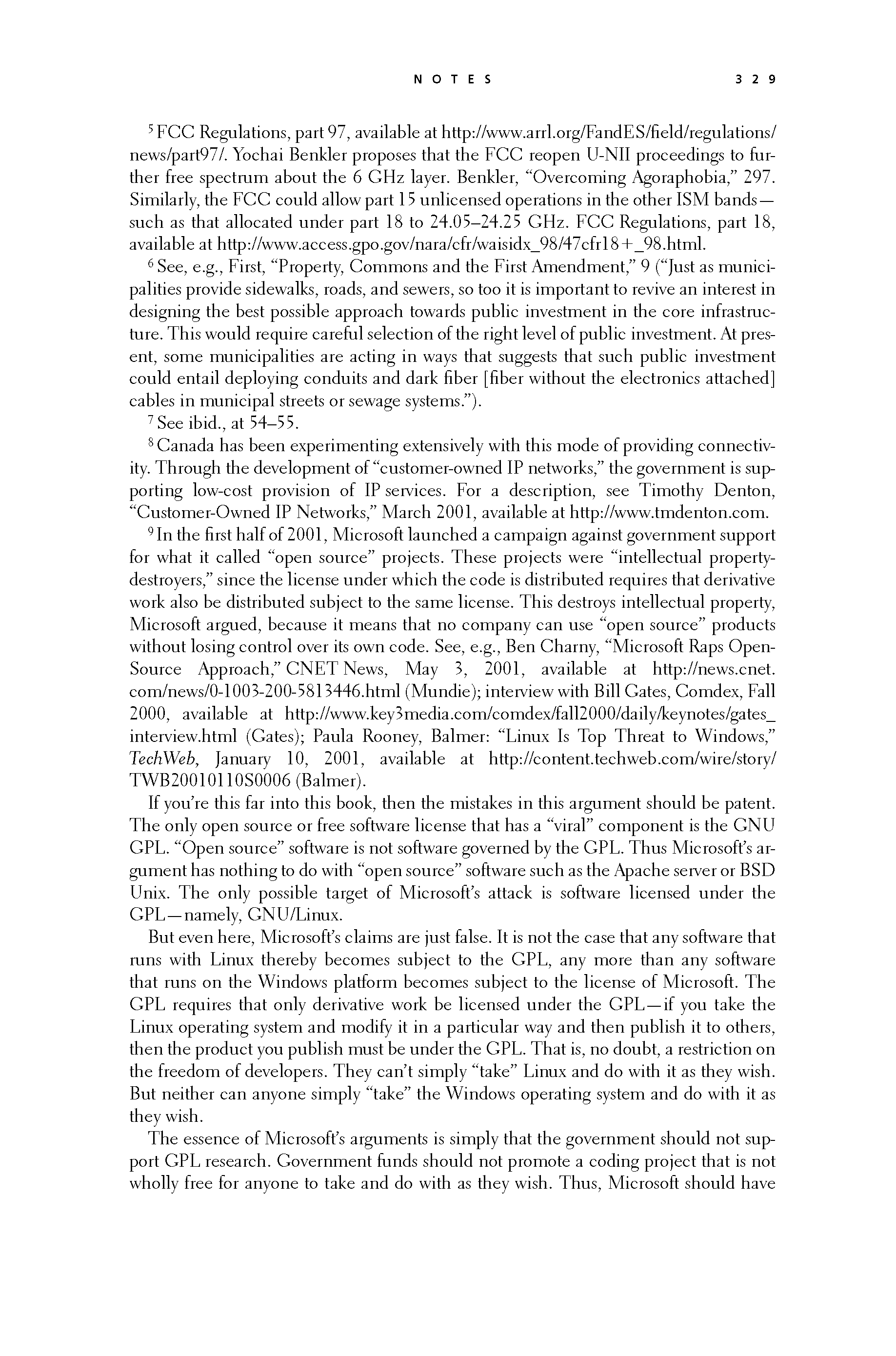 p328 _
-chap- _
toc-1 _
p329w _
toc-2 _
+chap+ _
p330
p328 _
-chap- _
toc-1 _
p329w _
toc-2 _
+chap+ _
p330
[14-5] FCC Regulations, part 97, available at http://www.arrl.org/FandES/field/regulations/
news/part97/. Yochai Benkler proposes that the FCC reopen U-NII proceedings to fur-
ther free spectrum about the 6 GHz layer. Benkler, "Overcoming Agoraphobia," 297.
Similarly, the FCC could allow part 15 unlicensed operations in the other ISM bands --
such as that allocated under part 18 to 24.05-24.25 GHz. FCC Regulations, part 18,
available at http://www.access.gpo.gov/nara/cfr/waisidx_98/47cfr18#_98.html.
[14-6] See, e.g., First, "Property, Commons and the First Amendment," 9 ("Just as munici-
palities provide sidewalks, roads, and sewers, so too it is important to revive an interest in
designing the best possible approach towards public investment in the core infrastruc-
ture. This would require careful selection of the right level of public investment. At pres-
ent, some municipalities are acting in ways that suggests that such public investment
could entail deploying conduits and dark fiber [fiber without the electronics attached]
cables in municipal streets or sewage systems.").
[14-7] See ibid., at 54-55.
[14-8] Canada has been experimenting extensively with this mode of providing connectiv-
ity. Through the development of "customer-owned IP networks," the government is sup-
porting low-cost provision of IP services. For a description, see Timothy Denton,
"Customer-Owned IP Networks," March 2001, available at http://www.tmdenton.com.
[14-9] In the first half of 2001, Microsoft launched a campaign against government support
for what it called "open source" projects. These projects were "intellectual property-
destroyers," since the license under which the code is distributed requires that derivative
work also be distributed subject to the same license. This destroys intellectual property,
Microsoft argued, because it means that no company can use "open source" products
without losing control over its own code. See, e.g., Ben Charny, "Microsoft Raps Open-
Source Approach," CNET News, May 3, 2001, available at http://news.cnet.
com/news/0-1003-200-5813446.html (Mundie); interview with Bill Gates, Comdex, Fall
2000, available at http://www.key3media.com/comdex/fall2000/daily/keynotes/gates_
interview.html (Gates); Paula Rooney, Balmer: "Linux Is Top Threat to Windows,"
_TechWeb,_ January 10, 2001, available at http://content.techweb.com/wire/story/
TWB20010110S0006 (Balmer).
If you're this far into this book, then the mistakes in this argument should be patent.
The only open source or free software license that has a "viral" component is the GNU
GPL. "Open source" software is not software governed by the GPL. Thus Microsoft's ar-
gument has nothing to do with "open source" software such as the Apache server or BSD
Unix. The only possible target of Microsoft's attack is software licensed under the
GPL -- namely, GNU/Linux.
But even here, Microsoft's claims are just false. It is not the case that any software that
runs with Linux thereby becomes subject to the GPL, any more than any software
that runs on the Windows platform becomes subject to the license of Microsoft. The
GPL requires that only derivative work be licensed under the GPL -- if you take the
Linux operating system and modify it in a particular way and then publish it to others,
then the product you publish must be under the GPL. That is, no doubt, a restriction on
the freedom of developers. They can't simply "take" Linux and do with it as they wish.
But neither can anyone simply "take" the Windows operating system and do with it as
they wish.
The essence of Microsoft's arguments is simply that the government should not sup-
port GPL research. Government funds should not promote a coding project that is not
wholly free for anyone to take and do with as they wish. Thus, Microsoft should have
[[329]]
p328 _
-chap- _
toc-1 _
p329w _
toc-2 _
+chap+ _
p330